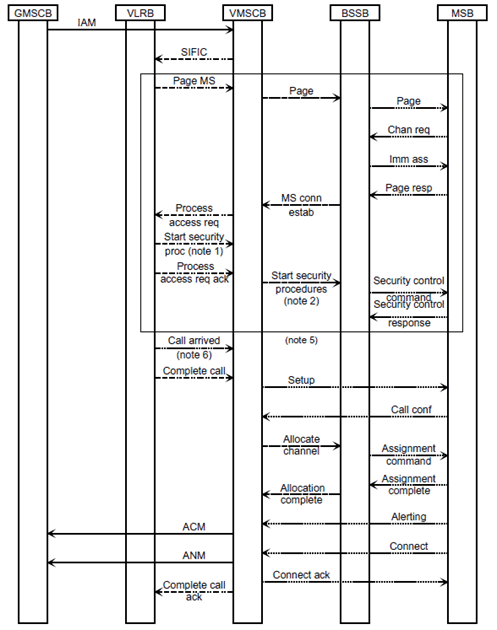Content for TS 23.018 Word version: 17.0.0
5.3 Information flow for an MT call p. 31
An example information flow for an MT call is shown in Figure 5; many variations are possible. ISUP signalling between GMSCB and VMSCB is shown by solid lines; signalling over the B interface between VMSCB and VLRB is shown by chain lines; signalling over the Iu interface (for UMTS) or the A interface (for GSM) between VMSCB and BSSB is shown by dashed lines; and signalling over the radio interface between VMSCB or BSSB and MSB is shown by dotted lines.

When VMSCB receives an IAM from GMSCB it sends to VLRB a request for information to handle the incoming call, using a Send Info For Incoming Call (SIFIC) message containing the roaming number received in the IAM.
If VLRB recognizes the roaming number, and MSB is allowed service, it sends a request to VMSCB to page MSB. If a radio connection between the network and MSB is already established, VMSCB responds immediately to the page request. If no radio connection exists, VMSCB sends a page request to BSSB, and BSSB broadcasts the page on the paging channel. If VPLMNB supports GPRS and the Gs interface between VLRB and the SGSN is implemented (see TS 23.060) and there is a valid association between VLRB and the SGSN for the MS, the paging signal towards the MS goes from VMSCB via VLRB and the SGSN to the BSS.
If MSB detects the page, it sends a channel request to BSSB, which responds with an immediate assignment command, to instruct MSB to use the specified signalling channel. MSB then sends a page response on the signalling channel; BSSB relays this to VMSCB. VMSCB sends a Process access request message to VLRB to indicate that MSB has responded to paging. VLRB may then initiate authentication, as described in TS 33.102 for UMTS and TS 43.020 for GSM. VLRB may also initiate security procedures at this stage, as described in TS 33.102 for UMTS and TS 43.020 for GSM.
If the MS is paged in a CSG cell, VLRB shall control if the CSG cell is allowed by the CSG subscription data stored in VLRB. If the CSG cell is not allowed, VLRB shall reject the the Process Access Request.
If the MS is paged in a hybrid cell, VLRA shall set the CSG membership status in the Process Access Request ack according to the CSG subscription data stored in VLRA.
VLRB may restore CSG data from CSS for a MT call after a VLRB restart.
If VLRB determines that MSB is allowed service, it sends a Process access request ack to VMSCB. The Process access request ack message triggers a Start security procedures message towards BSSB; if VMSCB has not received a Start security procedures message from VLRB, the Start security procedures message indicates no ciphering.
VLRB then sends a Complete call message to VMSCB. VMSCB sends a Set-up message towards MSB. The Set-up message may include bearer capability information for the call.
When MSB receives the Set-up message from BSSB, it responds with a Call confirmed message. The Call Confirmed message includes bearer capability information if any of the negotiable parameters of the bearer capability has to be changed. When VMSCB receives the Call confirmed message via BSSB, it sends an Allocate channel message to BSSB. BSSB instructs MSB to tune to a traffic channel by sending an Assignment command. When MSB has tuned to the specified traffic channel it responds with an Assignment complete, message, which BSSB relays to VMSCB as an Allocation complete, and sends an Alerting message to indicate that the called user is being alerted. VMSCB sends an ACM to GMSCB, which relays it to the originating exchange.
When the called user answers, MSB sends a Connect message, which BSSB relays to VMSCB. VMSCB:
- responds with a Connect ack message towards MSB;
- sends an ANM to GMSCB, which relays it to the originating exchange;
- sends a Complete call ack to VLRB.